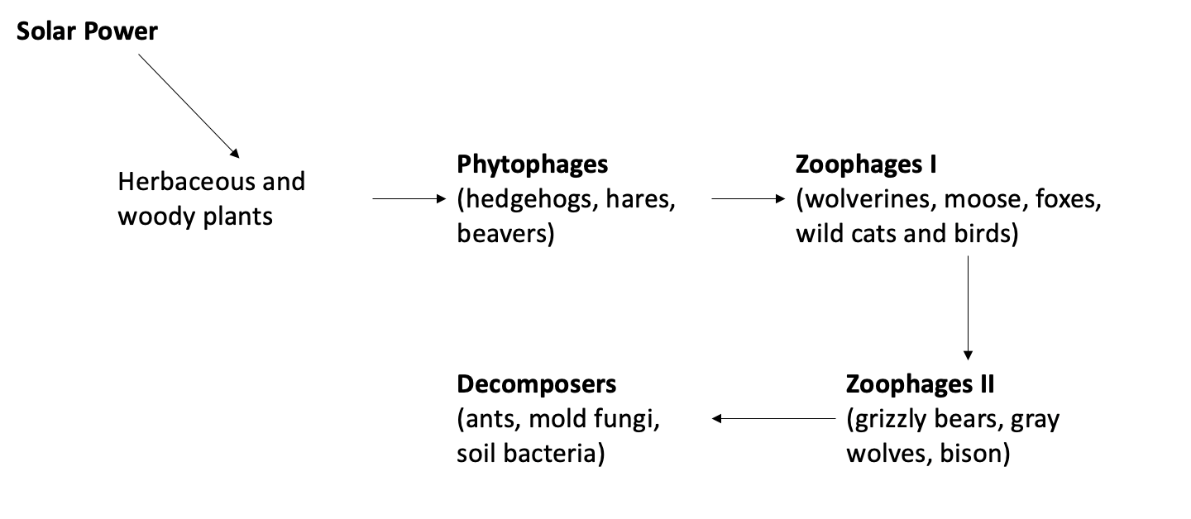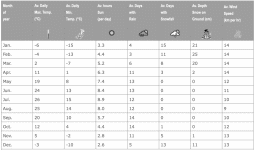Brief Definitions
It is often the case that incredible natural landscapes and landforms become so commonplace if humans live nearby that they cease to inspire natural grandeur and interest. Nevertheless, such areas remain areas rich in both biodiversity and geophysical dynamics. One such ecosystem has been chosen for discussion in this paper.
It should be emphasized that the term ecosystem used in this paper is considered a natural community characterized by a constant cycle of energy and resources, the presence of consumers, producers, and decomposers, as well as the interconnection of biotic and abiotic components (Knapp, 2020). The area chosen in this work is a mountainous terrain, which is a three-hundred-meter wooded green hill, which is dominated by trees. This ecosystem is familiar to the author because of its close proximity to home: thus, the author has visited this upland area several times and studied flora and fauna.
Exploring Aspects of the Ecosystem
Flora and Fauna
The biotic component of the selected ecosystem is a unique combination of animal life unique to biogeocenosis. In fact, the mountainous terrain near the house is represented by wild fauna, characteristic of the classic Canadian coloration. Here one can find small animals that feed mainly on the bark of trees or fruits of small plants: these include hedgehogs, wild hares, and cats, some species of local birds. At the same time, mountainous terrain has a structured trophic chain, so phytophages become victims of zoophagous of the first and then of the second level, as shown in Figure 1. It should be noted that the figure gives information about some dangerous animals, be they gray wolf, bison, or grizzly. The author has never personally encountered them during a walk, but the warning signs installed indicate this possibility. As seen in Figure 1, the local trophic chain is represented by all components of the natural ecosystem, where the arrows describe the transfer of energy between levels. Thus, by feeding on sunlight to produce glucose, plants become food for first-, second-, and third-level consumers. In turn, as a result of infectious disease or death, second-order zoophagous feed decomposers represented by native ants, bacteria, or fungi. Table 1 summarizes the results of independent observation and species identification.

Table 1. Summary of local animal and plant observations
For the selected ecosystem, a developed network of animal-plant relationships is also noticeable. Not only do plants provide valuable nutritional resources to phytophages, but some of the bird species also use trees for nesting or creating storage sites for food reserves — this is an example of commensalism. At the same time, a generally neutral relationship between species is realized when trees and grasses produce oxygen as a byproduct of their food, and this oxygen is used by animals for respiration. Mutualism describes the relationship between native insects and flowering plants: insects receive nutrients, and plants are pollinated. In addition, it cannot be ruled out the possibility that symbiotic bacteria may be present on the roots of some plant forms, which capture nutrients from the soil and metabolically transform them into organic forms (Wang et al., 2018). These combine to create a sure framework of relationships between the animals and plants of the upland area near the home.
In addition to a well-developed network of relationships and the presence of all necessary components, any ecosystem must have a historical context. More specifically, since an animal and plant community resides in the same biogeocenosis for a long time, it is natural to expect them to be characterized by unique adaptive traits (Ho & Zhang, 2018). For local flora and fauna in general, Bergmann’s and Allen’s rules are noticeable: this means that due to cold winter days, their bodies are larger with comparably smaller protruding parts such as ears, nose, and tail (Shelomi & Zeuss, 2017). Thus, native animals — and especially hares and foxes — are noticeably larger than their relatives from warmer regions, such as the United States. It is also relevant for hares to change their body coloration to off-white to create additional protection from hungry predators. In addition, bacterial cells almost certainly form cysts to exist during adverse conditions. An interesting example of adaptive transformation describes the life history of Canadian marmots: when winter arrives, they go into anabiotic states in which their body temperature drops and their heart rate and respiratory rate are markedly reduced.
Climate
The local climate, which determines the course of life in the selected ecosystem, is harmoniously represented by all seasons. Summer lasts from June to mid-September, and autumn takes all the time until the end of November. In December, winter begins, which brings animals and plants in poor conditions until mid-March, and from that time until June, spring lasts. Summers are quite hot and humid, with an average temperature of 25 degrees and 12.3 rainy days. In contrast, the local winter is incredibly harsh and snowy, with average temperatures below -10 degrees and 19 cm of snow. Figure 2 summarizes the numerical data on local climatic features. Finally, it should be noted that extreme weather conditions are generally uncommon for the local ecosystem, but tornadoes and hurricanes occasionally come here, as well as prolonged heavy rains. Nevertheless, water is not retained in the soil because of the hilly landscape, and floods are completely absent here.

Plant Adaptation
Not only animals but also plants are a necessary component of a stable ecosystem. In addition to Table 1, it should be mentioned some of the adaptive changes that are characteristic of the local flora. For example, gymnosperms plants here are characterized by narrow leaves, needles, which allow them to store moisture and evaporate less during the hot season: that is why such trees are green even in winter. In addition, the crowns of the trees here are arranged in a cascade. This means that even stunted woody plants get plenty of light because they are not in fierce competition with large plants like elm, oak, or maple. Because the flowering plants need help from insects to reproduce, their leaves are bright white or colored to attract attention. What is additionally interesting is that many of the native plants have a conical crown, which means snow will not linger and break off the branches.
Geological Features
It has already been emphasized that the selected ecosystem is a hilly terrain covered with woodlands. At the same time, the ecosystem is part of a larger biogeocenosis located on the inland lands of the continent: thus, the local lands cannot be classified as either insular or coastal. However, the humidity here is low, which can be justified by both the lack of fruit plants and the absence of lakes that feed the soil. These are infertile mountain-podzol soils, on which it is not easy to grow crops.
Anthropogenic Factor
Local news studies have reported no findings of positive human activity for local systems. In fact, individuals may pick up trash or remove grime, or helping local flora and fauna, but these are isolated instances. Instead, locals often use areas of the ecosystem for picnics, and valuable plants are cut down, and grasses are burned. In addition, since this is a mountainous area, it is not uncommon for municipal mining and sand.
References
The climate and weather of Ottawa, Ontario. (2020). Living in Canada. Web.
Ho, W. C., & Zhang, J. (2018). Evolutionary adaptations to new environments generally reverse plastic phenotypic changes. Nature Communications, 9(1), 1-11.
Knapp, S. (2020). Ecosystem. Biology Dictionary. Web.
Shelomi, M., & Zeuss, D. (2017). Bergmann’s and Allen’s rules in native European and Mediterranean Phasmatodea. Frontiers in Ecology and Evolution, 5, 25-38.
Wang, Q., Liu, J., & Zhu, H. (2018). Genetic and molecular mechanisms underlying symbiotic specificity in legume-rhizobium interactions. Frontiers in Plant Science, 9, 313-330.